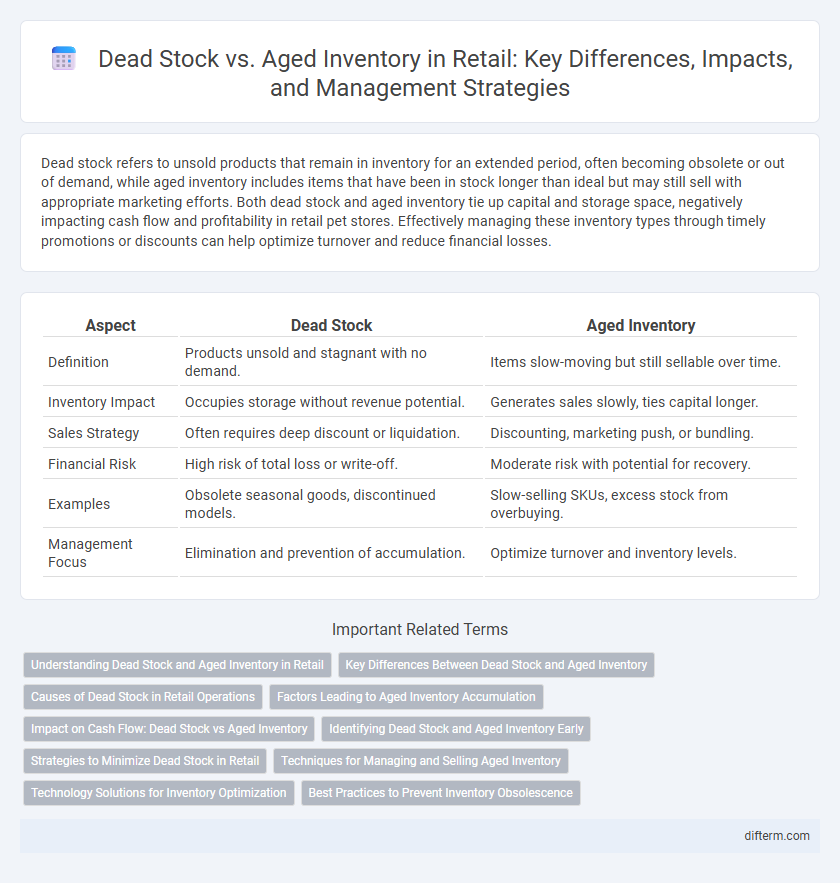Dead stock refers to unsold products that remain in inventory for an extended period, often becoming obsolete or out of demand, while aged inventory includes items that have been in stock longer than ideal but may still sell with appropriate marketing efforts. Both dead stock and aged inventory tie up capital and storage space, negatively impacting cash flow and profitability in retail pet stores. Effectively managing these inventory types through timely promotions or discounts can help optimize turnover and reduce financial losses.
Table of Comparison
| Aspect | Dead Stock | Aged Inventory |
|---|---|---|
| Definition | Products unsold and stagnant with no demand. | Items slow-moving but still sellable over time. |
| Inventory Impact | Occupies storage without revenue potential. | Generates sales slowly, ties capital longer. |
| Sales Strategy | Often requires deep discount or liquidation. | Discounting, marketing push, or bundling. |
| Financial Risk | High risk of total loss or write-off. | Moderate risk with potential for recovery. |
| Examples | Obsolete seasonal goods, discontinued models. | Slow-selling SKUs, excess stock from overbuying. |
| Management Focus | Elimination and prevention of accumulation. | Optimize turnover and inventory levels. |
Understanding Dead Stock and Aged Inventory in Retail
Dead stock in retail refers to products that remain unsold for an extended period, often becoming obsolete or outdated, resulting in a loss of capital and shelf space. Aged inventory includes items that have been in stock beyond their typical sales cycle but may still hold value or potential for discount sales. Effective inventory management strategies prioritize distinguishing between dead stock and aged inventory to optimize turnover rates and improve overall profitability.
Key Differences Between Dead Stock and Aged Inventory
Dead stock refers to products that have never been sold and remain unsold for an extended period, often resulting in complete obsolescence or discontinued status. Aged inventory consists of items that have been in stock for a prolonged time but were once actively selling, potentially requiring markdowns to clear. The key difference lies in dead stock's lack of demand and resale potential, while aged inventory may still hold value with proper pricing strategies.
Causes of Dead Stock in Retail Operations
Dead stock in retail operations primarily results from overordering, inaccurate demand forecasting, and seasonal product misalignment, leading to unsold merchandise that ties up capital. Product discontinuations, changes in consumer preferences, and poor inventory management also contribute significantly to stock stagnation. Inefficient supply chain coordination and delays in product turnover exacerbate dead stock accumulation, impacting overall profitability.
Factors Leading to Aged Inventory Accumulation
Dead stock and aged inventory accumulate primarily due to inaccurate demand forecasting, leading to overproduction or overordering of products that fail to sell. Seasonal product variations and rapid changes in consumer preferences cause unsold merchandise to remain in inventory for extended periods. Inefficient inventory management systems and lack of timely markdown strategies exacerbate the retention of aged inventory, tying up capital and warehouse space.
Impact on Cash Flow: Dead Stock vs Aged Inventory
Dead stock immobilizes capital as products remain unsold for extended periods, negatively affecting cash flow and increasing storage costs. Aged inventory ties up working capital by slowing turnover rates, reducing liquidity and limiting the ability to invest in new stock. Effective inventory management minimizes both dead stock and aged inventory to maintain healthy cash flow and optimize retail profitability.
Identifying Dead Stock and Aged Inventory Early
Identifying dead stock and aged inventory early involves analyzing sales velocity and inventory turnover rates to detect products with prolonged shelf time and low demand. Utilizing inventory management systems equipped with real-time data analytics helps flag items stagnant beyond a predefined threshold, indicating obsolescence or decreased market interest. Early detection enables retailers to implement targeted discounting strategies or liquidation plans, minimizing holding costs and optimizing cash flow.
Strategies to Minimize Dead Stock in Retail
Implementing accurate demand forecasting and inventory management software helps retailers reduce dead stock by aligning supply with customer preferences. Regular product audits and dynamic pricing strategies encourage the quick sale of slow-moving items, preventing inventory from aging. Collaborating with suppliers on flexible order quantities and replenishment cycles further minimizes excess stock and enhances cash flow.
Techniques for Managing and Selling Aged Inventory
Techniques for managing and selling aged inventory in retail include implementing dynamic pricing strategies such as markdowns and promotions to stimulate demand while minimizing losses. Utilizing inventory management software enables precise tracking and forecasting, helping retailers identify slow-moving products early and adjust procurement accordingly. Collaborating with clearance outlets or leveraging online marketplaces expands sales channels, effectively reducing dead stock and improving overall inventory turnover.
Technology Solutions for Inventory Optimization
Technology solutions for inventory optimization use AI-driven analytics to distinguish dead stock from aged inventory, enabling precise demand forecasting and automated replenishment. Advanced inventory management platforms integrate real-time sales data with predictive modeling to minimize holding costs and improve cash flow. Retailers leveraging IoT and blockchain technologies gain enhanced visibility and traceability, reducing dead stock accumulation and optimizing inventory turnover rates.
Best Practices to Prevent Inventory Obsolescence
Implement regular inventory audits and employ demand forecasting software to identify slow-moving products early, minimizing dead stock accumulation. Adopt just-in-time (JIT) inventory systems paired with supplier flexibility to reduce aged inventory risks by aligning stock levels with actual consumer demand. Enhance product lifecycle management through strategic markdowns and promotional activities to accelerate turnover and prevent inventory obsolescence.
Dead Stock vs Aged Inventory Infographic

 difterm.com
difterm.com